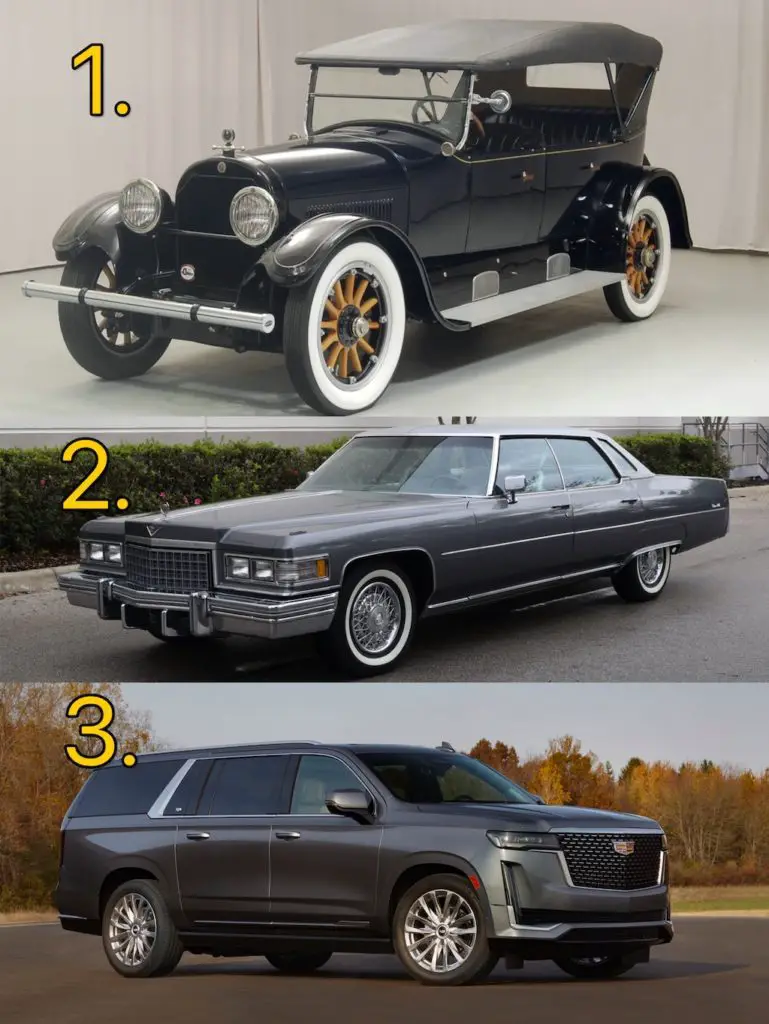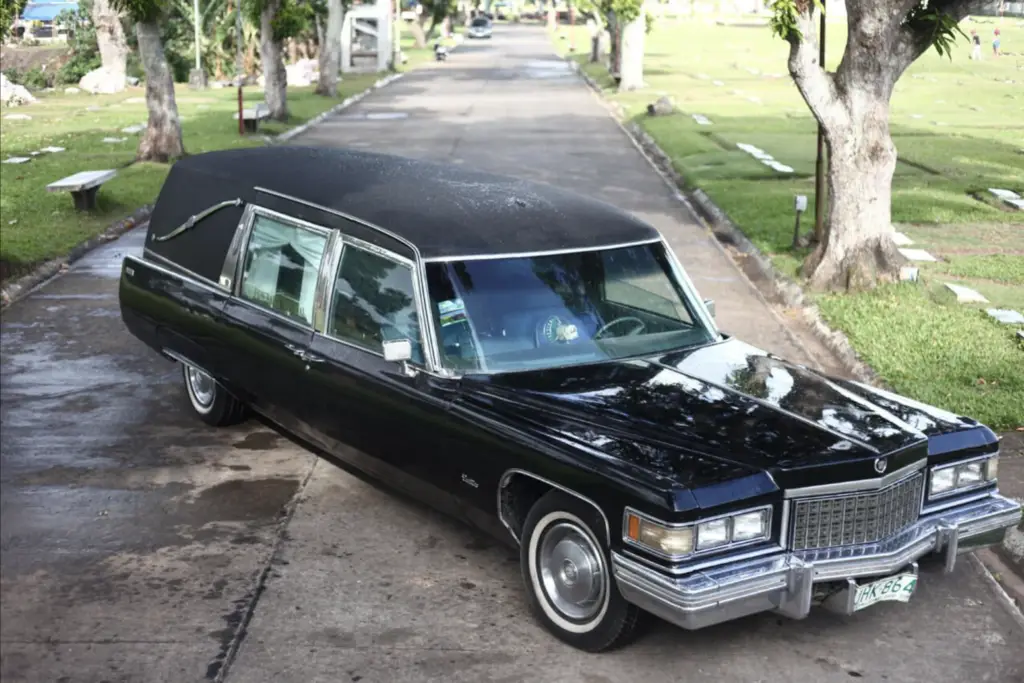Cadillac, which car comes closest in your mind when you hear the word, 1, 2 , or 3? (Show one from 1920, 1970, and 1920)

Chances are, you picked 2, as would most people. And that’s understandable. The Cadillac nameplate, over the last 30 years, has been quite aimless and lacking in identity despite their best efforts to reinvent themselves. Why is that?
If you want to see an analysis on a brand that is the OPPOSITE of Cadillac, check out this video or article.
Table of Contents
The Products
It’s not for lack of trying. For the last 20 years, Cadillac has produced some truly compelling automobiles, like the V-series of performance cars and the Cadillac Escalade Luxury SUV. In the last 10 years especially, they have truly put a lot of effort into making excellent products across the lineup.
The interiors have gone from typical, sub-par American to actually competitive for the luxury segment, with all the tech expected of a modern luxury car seamlessly integrated into the interior itself, and the driving experience. Exterior styling too has become a strong point, with the new models like the CT4 and CT5 looking quite handsome in my opinion. And the driving experience? Excellent by all accounts.
While BMW, Mercedes-Benz, and Audi have largely told customers that want a manual transmission option in the highest performance sedans to go screw themselves, Cadillac has kept the option for the high-performance CT4 and CT5 Blackwing sedans, in theory, giving it huge credibility among the enthusiast community. The predecessors of these two sedans respectively, the compact ATS-V and midsize CTS-V also had the option as well, and were both heavily praised for their driving dynamics like the more recent blackwing offerings.
As a result, the the modern offerings from Cadillac are, by all accounts, excellent cars.
The Problem
At the end of the day though, nobody gives a damn. GM may be making thoroughly modern and excellent luxury cars, but what are those luxury cars called? Cadillac. And that’s exactly why nobody really cares.
To understand this, we must know what a Cadillac is seen as. For most of the public, it is a large, V8-engined, traditional American luxury car that is less a car, and more a land yacht.
It is complete with poor handling, lots of aggro, fake wood and velour all over the interior indicating questionable build quality, and a LOT of interior space due to front bench seats lacking a center console which allow the traditionally large middle American posterior to spread out accordingly.
Styling is flamboyant yet traditional, and is loaded with chrome all around. To top it all off, partial or full white wall tires, a front-and-center mounted hood ornament, a landau top, and written branding fonts in a cursive font are mandatory.
This image it shares with its traditional American rival, Lincoln, Ford’s Luxury division, and both images are firmly rooted in the 1970s.
However, while Lincoln became entirely associated as the cheesy go-to of airport chauffeurs and limo drivers, Cadillac’s niche was something much worse.

Like Lincoln, Cadillacs have become known as old people cars. But, unlike Lincoln, Cadillacs have more strongly become known as DEAD PEOPLE CARS. A quick google image search confirms this, as 5 of the 8 first images for the search term “hearse” are images of Cadillacs.
Even one of the most iconic movie cars of the 1980s, the ectomobile, plays into this. It is a modified Cadillac ambulance that is central in the movie GHOSTBUSTERS. Ghosts. Are. DEAD!
The problems of the brand’s stereotypes run very deep, and are even embodied inadvertently into the 1963-2014 Cadillac corporate logo itself (a.k.a. the one everyone thinks of).
At the center of the logo is the coat of arms for the late 17th century French explorer that founded the city of Detroit and namesake of the company, Antoine de la Mothe Cadillac. Maybe having a coat of arms was a sign of pedigree and prestige 125 years ago, but in the 2022? It’s so tacky, not even Donald Trump would put it on his hotel bath towels!
And that tackiness is also associated with stuffiness and an outdated definition of exclusivity that only partially works on the very oldest of customers. And realistically, how long will they be able to drive for anyway?
The second part of the traditional Cadillac logo, an outer wreath, is also a problem. It bears MORE than a passing resemblance to the customary wreath of flowers to be used at FUNERALS and WAKES (a traditional viewing of the corpse of a recently deceased person), and for a car brand that is already associated with funeral cars, this solidifies the association between the Cadillac brand and dead people.
This is a problem, because dead people aren’t exactly buying a lot of stuff.
In addition, the traditionally poor build quality associated with American cars, especially luxury cars, means that for older people with money, Cadillac is far from aspirational for them. In fact, older people with money go often more for German brands and Lexus than anything else due to the perceived quality, as during the 1990s, they likely traded their Cadillacs in for Lexuses and Mercedes-Benzes.
As for current Cadillac buyers? The few that remain are often trading in Fords and Chevrolets to buy them, and those brands are traditionally associated with older, rust-belt residing white Americans.
That is already culturally the opposite of aspirational in contemporary discourse, and given the economic malaise of the rust belt, can you really expect this demographic to be able to spend 60-70k PLUS on a LUXURY CAR? A hard sell when the social security check doesn’t go that far on even the basic necessities.
It doesn’t matter how good of a car GM makes. The Cadillac brand will always be a big barge of an American car with a V8 engine that is for old people and dead people. Do NOT expect to change your customers’ minds on this.
Solutions
Copying BMW for the last 10 years has resulted in excellent cars, but crickets in the marketplace. Cadillac, for 2019 (the last “normal” year before supply chain disruptions distorted the market) sold 156k units in the U.S, while Mercedes-Benz, Audi, and BMW combined sold nearly A MILLION within the same time period. 6 TIMES MORE. Those results, unfortunately, are not going to cut it for shareholders.
And it’s not like GM is unaware of this problem. They are. Since 2014, they have tried to “reinvent” Cadillac twice. They tried changing the logo and ditching the wreath first, moving the HQ to SoHo in Manhattan, creating an all-new, bespoke V8 engine, and making capable, fun performance cars that drive well and check all the right boxes for enthusiasts in an effort to connect with younger buyers. Didn’t work.
So now they are trying to do it again. Change the coat of arms logo to monochromatic, making a push for all electric, and emphasizing an online sales model. This won’t work either.
Monochromatic logo? GM is already the embodiment of big corporate, a monochromatic logo here makes me wonder if GM management is secretly the Pixies from the Fairly Odd Parents!
All electric? Hard sell if your customers are rural and have few public transit options given the current limitations of electric vehicles.
Online? Again, Cadillac buyers are OLD and LESS EDUCATED. Why would you make it harder for them to buy your car?
On a side note, while researching this article, I found this piece online talking about the SECOND reinvention of the Cadillac brand. Front and center was the vice-president of Cadillac North America Sales, Mahmoud Samara. One look at this guy, and my first thought was “An AI experiment with the business school has recently escaped. It is NOT ready for commercial use.”
Despite the current solutions not working, there is a way out. Two, actually, depending on GM’s goal. Is the goal to sell more cars that are currently on offer, like the CT4, CT5, and Escalade. Or is the goal to resurrect the Cadillac brand and bring it back to marketplace relevance?
If the goal is the safe goal of simply selling more units with the type of products they have already developed, then the Cadillac brand NEEDS to be KILLED OFF. The current products, by all measurable metrics, are EXCELLENT and MODERN, but keeping them beholden to a brand that is a huge disservice that doesn’t do the products justice.
Cadillac fans, that LIKE big boats of American cars, continue to become more alienated by the direction of the brand, and people that would otherwise like the products (such as myself) are turned away by the stodgy image of Cadillac.
GM has the expertise to start a brand from the ground up, they did it with Saturn in the 1990s, and the current direction of GM luxury cars would make much more sense if they WEREN’T called Cadillac.
If the goal is to revive the Cadillac brand, the current products will NOT do. They are many things, but they AREN’T Cadillacs. Yes, it may be a car associated with dead people and times past, so OWN IT! Yeah, Cadillacs are common hearses and associated with the old and the dead, so what?
Now, imagine a Cadillac ad, directed by Tim Burton, add a caption about how during research, turns out, they did, but not enough, as I too fall victim to not caring what Cadillac does), starring Helena Bonham Carter. If Cadillac did that, they would OWN the market of that subculture. There is a market for it after all!
With the older image, they could easily call to mind the early 20th century era in which the brand was founded. Steampunk aesthetic has a following, as the popularity of Legend of Korra, The Great Gatsby, and Fantastic Beasts has shown. Using steampunk styling cues would ABSOLUTELY work. Plus, the idea of an American luxury car is already so divergent from the norm in the car market of 2022, and younger generations crave AUTHENTICITY. Owning that difference will attract people, not push them away, and would make Cadillac look hipster, not ancient.
Summary
While Cadillac as a brand is pretty far gone from a desirability perspective, with some unconventional repositioning, it could carve out a truly unique market niche that would revive it and make it thrive. It also serves as a textbook example of how it doesn’t matter how good your products are, if you have a bad brand, they won’t sell. And it also shows that if you don’t own what you are, you will always fail. Valuable words for both business and life in general.
